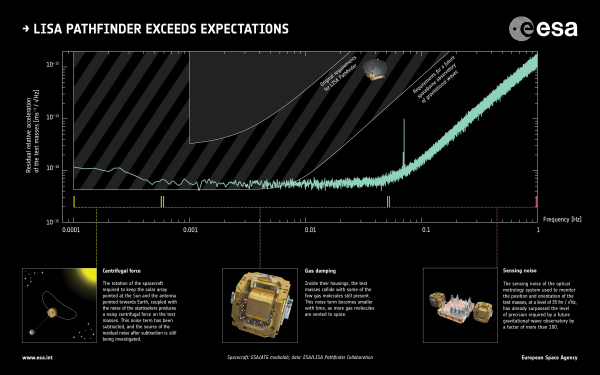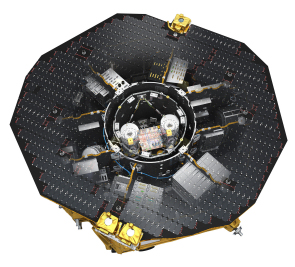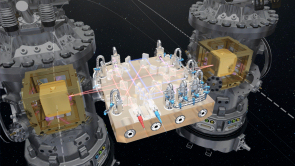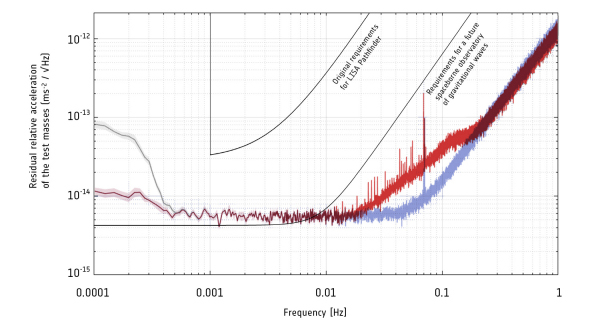LISA Pathfinder exceeds expectations
7 June 2016
ESA's LISA Pathfinder mission has demonstrated the technology needed to build a space-based gravitational wave observatory. |
| LISA Pathfinder performance. Credit: spacecraft: ESA/ATG medialab; data: ESA/LISA Pathfinder Collaboration |
Results from only two months of science operations show that the two cubes at the heart of the spacecraft are falling freely through space under the influence of gravity alone, unperturbed by other external forces, to a precision more than five times better than originally required.
In a paper published today in Physical Review Letters, the LISA Pathfinder team show that the test masses are almost motionless with respect to each other, with a relative acceleration lower than ten millionths of a billionth of Earth's gravity.
 |
| Inside the LISA Pathfinder science module. Credit: ESA/ATG medialab |
The demonstration of the mission's key technologies opens the door to the development of a large space observatory capable of detecting gravitational waves emanating from a wide range of exotic objects in the Universe.
Hypothesised by Albert Einstein a century ago, gravitational waves are oscillations in the fabric of spacetime, moving at the speed of light and caused by the acceleration of massive objects.
They can be generated, for example, by supernovas, neutron star binaries spiralling around each other, and pairs of merging black holes.
Even from these powerful objects, however, the fluctuations in spacetime are tiny by the time they arrive at Earth – smaller than 1 part in 100 billion billion.
Sophisticated technologies are needed to register such minuscule changes, and gravitational waves were directly detected for the first time only in September 2015 by the ground-based Laser Interferometer Gravitational-Wave Observatory (LIGO).
This experiment saw the characteristic signal of two black holes, each with some 30 times the mass of the Sun, spiralling towards one another in the final 0.3 seconds before they coalesced to form a single, more massive object.
The signals seen by LIGO have a frequency of around 100 Hz, but gravitational waves span a much broader spectrum. In particular, lower-frequency oscillations are produced by even more exotic events such as the mergers of supermassive black holes.
With masses of millions to billions of times that of the Sun, these giant black holes sit at the centres of massive galaxies. When two galaxies collide, these black holes eventually coalesce, releasing vast amounts of energy in the form of gravitational waves throughout the merger process, and peaking in the last few minutes.
To detect these events and fully exploit the new field of gravitational astronomy, it is crucial to open access to gravitational waves at low frequencies between 0.1 mHz and 1 Hz. This requires measuring tiny fluctuations in distance between objects placed millions of kilometres apart, something that can only be achieved in space, where an observatory would also be free of the seismic, thermal and terrestrial gravity noises that limit ground-based detectors.
LISA Pathfinder was designed to demonstrate key technologies needed to build such an observatory.
 |
| Freely Floating in space. Credit: ESA/ATG medialab |
A crucial aspect is placing two test masses in freefall, monitoring their relative positions as they move under the effect of gravity alone. Even in space this is very difficult, as several forces, including the solar wind and pressure from sunlight, continually disturb the cubes and the spacecraft.
Thus, in LISA Pathfinder, a pair of identical, 2 kg, 46 mm gold–platinum cubes, 38 cm apart, fly, surrounded, but untouched, by a spacecraft whose job is to shield them from external influences, adjusting its position constantly to avoid hitting them.
"LISA Pathfinder's test masses are now still with respect to each other to an astonishing degree," says Alvaro Giménez, ESA's Director of Science.
"This is the level of control needed to enable the observation of low-frequency gravitational waves with a future space observatory."
LISA Pathfinder was launched on 3 December 2015, reaching its operational orbit roughly 1.5 million km from Earth towards the Sun in late January 2016.
The mission started operations on 1 March, with scientists performing a series of experiments on the test masses to measure and control all of the different aspects at play, and determine how still the masses really are.
"The measurements have exceeded our most optimistic expectations," says Paul McNamara, LISA Pathfinder Project Scientist.
"We reached the level of precision originally required for LISA Pathfinder within the first day, and so we spent the following weeks improving the results a factor of five."
These extraordinary results show that the control achieved over the test masses is essentially at the level required to implement a gravitational wave observatory in space.
"Not only do we see the test masses as almost motionless, but we have identified, with unprecedented precision, most of the remaining tiny forces disturbing them," explains Stefano Vitale of University of Trento and INFN, Italy, Principal Investigator of the LISA Technology Package, the mission's core payload.
The first two months of data show that, in the frequency range between 60 mHz and 1 Hz, LISA Pathfinder's precision is only limited by the sensing noise of the laser measurement system used to monitor the position and orientation of the cubes.
"The performance of the laser instrument has already surpassed the level of precision required by a future gravitational-wave observatory by a factor of more than 100," says Martin Hewitson, LISA Pathfinder Senior Scientist from Max Planck Institute for Gravitational Physics and Leibniz Universität Hannover, Germany.
| LISA Pathfinder performance (click here to access the video and more details). Credit: spacecraft: ESA/ATG medialab; data: ESA/LISA Pathfinder Collaboration |
At lower frequencies of 1–60 mHz, control over the cubes is limited by gas molecules bouncing off them – a small number remain in the surrounding vacuum. This effect was seen reducing as more molecules were vented into space, and is expected to improve in the following months.
"We have observed the performance steadily improving, day by day, since the start of the mission," says William Weber, LISA Pathfinder Senior Scientist from University of Trento, Italy.
At even lower frequencies, below 1 mHz, the scientists measured a small centrifugal force acting on the cubes, from a combination of the shape of LISA Pathfinder's orbit and to the effect of the noise in the signal of the startrackers used to orient it.
While this force slightly disturbs the cubes' motion in LISA Pathfinder, it would not be an issue for a future space observatory, in which each test mass would be housed in its own spacecraft, and linked to the others over millions of kilometres via lasers.
"At the precision reached by LISA Pathfinder, a full-scale gravitational wave observatory in space would be able to detect fluctuations caused by the mergers of supermassive black holes in galaxies anywhere in the Universe," says Karsten Danzmann, director at the Max Planck Institute for Gravitational Physics, director of the Institute for Gravitational Physics of Leibniz Universität Hannover, Germany, and Co-Principal Investigator of the LISA Technology Package.
Today's results demonstrate that LISA Pathfinder has proven the key technologies and paved the way for such an observatory, as the third 'Large-class' (L3) mission in ESA's Cosmic Vision programme.
Notes for Editors
"Sub-femto-g free-fall for space-based gravitational wave observatories: LISA Pathfinder results," is published in Physical Review Letters.
The results were presented today during a media briefing at ESA's European Space Astronomy Centre in Villanueva de la Cañada, Madrid, Spain.
There will be an Ask Me Anything session on Reddit on 7 June at 14:00 CEST (12:00 UTC).
LISA Pathfinder is an ESA mission with important contributions from its member states and NASA.
The LISA Technology Package payload has been delivered by several national funding agencies and ESA, in particular: Italy (ASI); Germany (DLR); the United Kingdom (UKSA); France (CNES); Spain (CDTI); Switzerland (SSO); and the Netherlands (SRON). LISA Pathfinder also carries the Disturbance Reduction System payload, provided by NASA-JPL.
Science operations involving the full LISA Technology Package will last until late June, followed by three months of operations with the Disturbance Reduction System.
For further information, please contact:
ESA Media Relations Office
Tel: +33 1 53 69 72 99
Email: media![]() esa.int
esa.int







